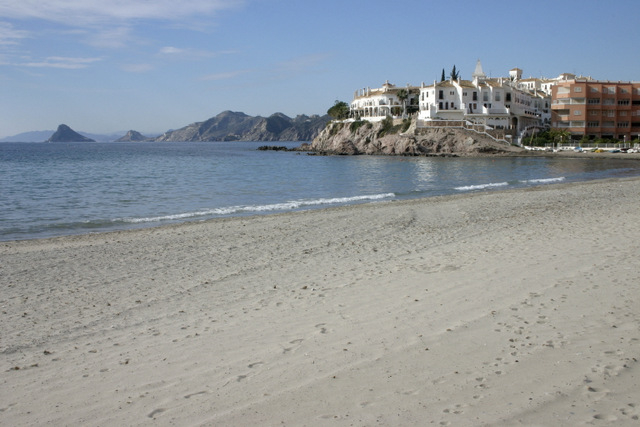Contact Águilas Tourist Office on +34 968 493 285
Send an Email
Click Here

The coastline of Águilas in the south-west of the Region of Murcia is rightly renowned for the variety of its beaches, from small, unspoilt and relatively inaccessible coves to wide swathes of pristine sand in urban settings, but within this latter category the beach of Calabardina tends to be forgotten.

The reason for this is that it is not in the centre of Águilas, but instead on the seafront of the smaller town of Calabardina, which was not much more than a tiny fishing hamlet until it was “discovered” by tourists in the 1960s and 1970s. Now it is a pleasant holiday town, neither too big nor too small, although inevitably the population drops sharply outside the main summer season of July and August.
The main beach in Calabardina (there is also the cove of Playa Canalicas and the stretch of coastline on the west of the town known as Playa de La Cola) is without a doubt the central feature of the town, consisting of around half a kilometre of fine white-yellow sand in the shadow of the headland of Cabo Cope. A wide range of facilities are provided during the summer, including a Red Cross and lifeguard point, a chemical toilet, access for the disabled (and a specially adapted bathing chair which can be used if booked in advance), foot showers and even a tourist information point just set back from the sand on the other side of the coastal street.
A restaurant at the eastern end of the beach is open all year round and two others open in the summer at the western end, as well as a beach bar. Other facilities in Calabardina include a few small shops, and there is a dispensing chemist’s no more than 50 metres from the beach itself.
The only reminder of Calabardina’s fishing past is the survival of a small wooden jetty at the eastern end of the sand, but nowadays the boats moored in the water are almost exclusively leisure craft and this, like the rest of the Águilas coastline, is a popular and rewarding area for scuba divers.
The range of facilities at Calabardina has resulted in the Q for Quality flag being flown from the Red Cross and lifeguard point for the last few years, and this is a highly recommended beach for anyone who enjoys all of the convenience of a city centre location without the larger crowds which can accumulate on the main urban beaches of Águilas during the summer.

How to get there and parking
Calabardina is located on the RM-D15 road in the south-western corner of the municipality of Águilas, and can be reached from Águilas itself by heading eastwards out of town on the RM-D14 from the junction on the ring road just north of the Águilas Plaza shopping centre.
Those approaching from other directions should also head for the RM-D14 road. From Lorca take the RM-11 motorway south towards Águilas and head east on the ring road, and from Cartagena and Mazarrón take the exit at kilometre 866 on the AP-7 toll motorway and follow the signs towards Calabardina and Cabo Cope.
For ten months of the year parking very close to the beach of Calabardina is not at all problematic, but of course in July and August, as at other urban beaches throughout the Costa Cálida and the rest of Spain, it may be necessary to leave the car a short walk from the sand. Most of the residential streets of Calabardina are wide enough to afford plenty of parking opportunities, and apart from those which climb the lower slopes of Cabo Cope they do not demand too hard an uphill slog when returning from a few hours on the sand!
This is the twenty fourth beach in the series of 36 Águilas beaches which run along the 28 kilometres of Águilas coast, working from the Almería coastline in the west down to the Lorca municipality and offer both urban and wild beaches.
Click for full list of Águilas beaches
More information about Águilas including beaches, what to see, what's on and tourist information can be found on ÁGUILAS TODAY




Hello, and thank you for choosing CamposolToday.com to publicise your organisation’s info or event.
Camposol Today is a website set up by Murcia Today specifically for residents of the urbanisation in Southwest Murcia, providing news and information on what’s happening in the local area, which is the largest English-speaking expat area in the Region of Murcia.
When submitting text to be included on Camposol Today, please abide by the following guidelines so we can upload your article as swiftly as possible:
Send an email to editor@camposoltoday.com or contact@murciatoday.com
Attach the information in a Word Document or Google Doc
Include all relevant points, including:
Who is the organisation running the event?
Where is it happening?
When?
How much does it cost?
Is it necessary to book beforehand, or can people just show up on the day?
…but try not to exceed 300 words
Also attach a photo to illustrate your article, no more than 100kb
